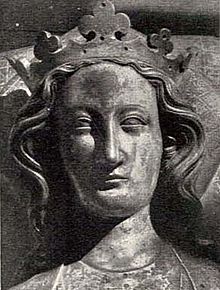
Back إليانور من قشتالة (ملكة إنجلترا) Arabic اليانور من كاستييا ملكه انجلترا ARZ Lleonor de Castiella AST النور کاستیل AZB Элеанора Кастыльская (каралева Англіі) Byelorussian Елинор Кастилска Bulgarian Leonor Kastilha (1244-1290) Breton Elionor de Castella (reina consort d'Anglaterra) Catalan ئێلەنۆری کاستایل CKB Eleonora Kastilská (1241–1290) Czech
| Eleanor of Castile | |
|---|---|
 Tomb effigy of Eleanor at Westminster Abbey | |
| Queen consort of England | |
| Tenure | 20 November 1272 – 28 November 1290 |
| Coronation | 19 August 1274 |
| Countess of Ponthieu | |
| Reign | 16 March 1279 – 28 November 1290 |
| Predecessor | Joan |
| Successor | Edward II |
| Alongside | Edward I |
| Born | 1241 Burgos, Castile |
| Died | 28 November 1290 (aged 48–49) Harby, Nottinghamshire, England |
| Burial | 17 December 1290 Westminster Abbey, London, England |
| Spouse | |
| Issue more... | |
| House | Ivrea |
| Father | Ferdinand III of Castile |
| Mother | Joan, Countess of Ponthieu |
Eleanor of Castile (1241 – 28 November 1290) was Queen of England as the first wife of Edward I. She was educated at the Castilian court and also ruled as Countess of Ponthieu in her own right (suo jure) from 1279. After diplomatic efforts to secure her marriage and affirm English sovereignty over Gascony, 13-year-old Eleanor was married to Edward at the monastery of Las Huelgas, Burgos, on 1 November 1254. She is believed to have birthed a child not long after.
Fuller records of Eleanor's life with Edward start from the time of the Second Barons' War onwards, when Simon de Montfort's government imprisoned her in Westminster Palace. Eleanor took an active role in Edward's reign as he began to take control of Henry III's post-war government. The marriage was particularly close; Edward and Eleanor travelled together extensively, including the Ninth Crusade, during which Edward was wounded at Acre.[a] Eleanor was capable of influencing politics but died too young to have much effect.
In her lifetime, Eleanor was disliked for her property dealings; she bought up vast lands such as Leeds Castle from the middling landed classes after they went into arrears on loan repayments to Jewish moneylenders, and the Crown forced them to sell their bonds. These transactions associated Eleanor with the abuse of usury and the supposed exploitation of Jews, bringing her into conflict with the church. She profited from the hanging of over 300 Jewish alleged coin clippers and after the Expulsion of the Jews in 1290, she gifted the former Canterbury Synagogue to her tailor. Eleanor died at Harby near Lincoln in late 1290; following her death, Edward built a stone cross at each stopping place on the journey to London, ending at Charing Cross. This series of monuments may have included the renovated tomb of Little St Hugh – who was falsely believed to have been ritually murdered by Jews – to bolster her reputation as an opponent of supposed Jewish criminality.
Eleanor exerted a strong cultural influence. She was a keen patron of literature and encouraged the use of tapestries, carpets and tableware in the Spanish style, as well as innovative garden designs. She was a generous patron of the Dominican friars, founding priories in England, and supporting their work at Oxford and Cambridge universities. Notwithstanding the sources of her wealth, Eleanor's financial independence had a lasting impact on the institutional standing of English queens, establishing their future independence of action. After her death, Eleanor's reputation was shaped by conflicting fictitious accounts – both positive and negative – portraying her as either the dedicated companion of Edward I or as a scheming Spaniard. These accounts influenced the fate of the Eleanor crosses, for which she is probably best known today. Historians have generally neglected Eleanor and her reign as a topic of serious study, but she has received more attention since the 1980s.
Cite error: There are <ref group=lower-alpha> tags or {{efn}} templates on this page, but the references will not show without a {{reflist|group=lower-alpha}} template or {{notelist}} template (see the help page).
© MMXXIII Rich X Search. We shall prevail. All rights reserved. Rich X Search